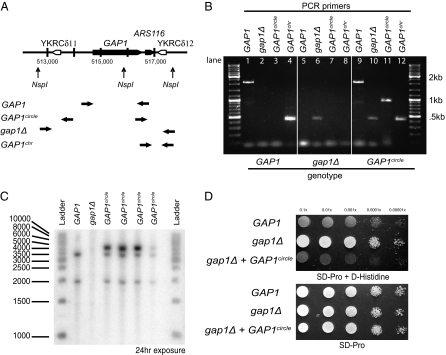Fig. 3.
Test for the presence of a circular extrachromosomal molecule containing a functional GAP1. (A) Schematic representation of the wild-type chromosomal allele of GAP1. Horizontal arrows represent annealing sites for PCR primers used for verification of the wild-type GAP1 ORF, GAP1circle, gap1Δ, and the chromosomal presence of GAP1. NspI restriction sites are indicated. (B) Agarose gel electrophoresis of PCR products obtained from three different genotypes of GAP1 (indicated below image). Wild-type GAP1 results in PCR amplification of the ORF and chromosomal fragment (lanes 1 and 4); deletion of GAP1 results in the deletion product only (lane 6); the presence of the GAP1circle results in a PCR product using primers that face the opposite direction in a chromosomal context (lane 11). In addition, PCR products corresponding to the ORF and deletion allele are detected (lanes 9 and 10). We also find evidence for the chromosomal location of GAP1 in a clone containing the GAP1circle (lane 12). (C) Southern blot analysis of the three different GAP1 genotypes. Two bands of expected size 3,213 bp and 1,929 bp are detected for the clone carrying the wild-type GAP1 allele. No signal is detected for the clone with the gap1Δ allele. The predicted GAP1circle is 4,252 bp and contains a single NspI site. We detect a single band corresponding to the expected size of the linearized product in four GAP1circle clones (Table 1). In addition, we detect bands corresponding to the wild-type GAP1 locus in all four GAP1circle-containing strains. (D) Growth of GAP1, gap1Δ, and gap1Δ transformed with the GAP1circle on minimal media containing proline and d-histidine. The presence of a wild-type GAP1 allele confers sensitivity to d-histidine, whereas loss of GAP1 (gap1Δ) results in resistance. Introduction of the plasmid DNA recovered from a GAP1circle strain into a gap1Δ strain confers sensitivity, confirming that the GAP1circle contains a functional copy of GAP1. All genotypes are able to grow in minimal media containing proline. Tenfold dilutions from an overnight culture are shown.

